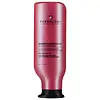What's inside
What's inside
 Key Ingredients
Key Ingredients

No key ingredients
 Benefits
Benefits

No benefits
 Concerns
Concerns

 Ingredients Side-by-side
Ingredients Side-by-side

Water
Skin ConditioningCetearyl Alcohol
EmollientGlycerin
HumectantBehentrimonium Chloride
PreservativeCetyl Esters
EmollientIsopropyl Myristate
EmollientQuaternium-80
Propylene Glycol
HumectantParfum
MaskingPolysorbate 20
EmulsifyingIsopropyl Alcohol
SolventPhenoxyethanol
PreservativePolyquaternium-37
Propylene Glycol Dicaprylate/Dicaprate
EmollientTocopherol
AntioxidantSesamum Indicum Seed Oil
EmollientButyrospermum Parkii Butter
Skin ConditioningCamellia Oleifera Seed Oil
Skin ConditioningButylene Glycol
HumectantDilauryl Thiodipropionate
AntioxidantHelianthus Annuus Seed Extract
Skin ConditioningPPG-1 Trideceth-6
Skin ConditioningHydrolyzed Vegetable Protein Pg-Propyl Silanetriol
Skin ConditioningCitric Acid
BufferingPelargonium Graveolens Flower Oil
MaskingAscorbic Acid
AntioxidantBenzophenone-4
UV AbsorberSorbitan Oleate
EmulsifyingPotassium Sorbate
PreservativeWater, Cetearyl Alcohol, Glycerin, Behentrimonium Chloride, Cetyl Esters, Isopropyl Myristate, Quaternium-80, Propylene Glycol, Parfum, Polysorbate 20, Isopropyl Alcohol, Phenoxyethanol, Polyquaternium-37, Propylene Glycol Dicaprylate/Dicaprate, Tocopherol, Sesamum Indicum Seed Oil, Butyrospermum Parkii Butter, Camellia Oleifera Seed Oil, Butylene Glycol, Dilauryl Thiodipropionate, Helianthus Annuus Seed Extract, PPG-1 Trideceth-6, Hydrolyzed Vegetable Protein Pg-Propyl Silanetriol, Citric Acid, Pelargonium Graveolens Flower Oil, Ascorbic Acid, Benzophenone-4, Sorbitan Oleate, Potassium Sorbate
Water
Skin ConditioningCetearyl Alcohol
EmollientAmodimethicone
Behentrimonium Chloride
PreservativeCetyl Esters
EmollientParfum
MaskingIsopropyl Alcohol
SolventTrideceth-6
EmulsifyingPhenoxyethanol
PreservativeBenzyl Salicylate
PerfumingHexyl Cinnamal
PerfumingCetrimonium Chloride
AntimicrobialLinalool
PerfumingBenzyl Alcohol
PerfumingLimonene
PerfumingChlorhexidine Dihydrochloride
AntimicrobialRosmarinus Officinalis Leaf Oil
MaskingEthylhexyl Salicylate
UV AbsorberGeraniol
PerfumingWater, Cetearyl Alcohol, Amodimethicone, Behentrimonium Chloride, Cetyl Esters, Parfum, Isopropyl Alcohol, Trideceth-6, Phenoxyethanol, Benzyl Salicylate, Hexyl Cinnamal, Cetrimonium Chloride, Linalool, Benzyl Alcohol, Limonene, Chlorhexidine Dihydrochloride, Rosmarinus Officinalis Leaf Oil, Ethylhexyl Salicylate, Geraniol
Ingredients Explained
These ingredients are found in both products.
Ingredients higher up in an ingredient list are typically present in a larger amount.
This ingredient is a preservative and often used for it's anti-static properties. You'll most likely see this ingredient in hair conditioners.
It does not cause irritation or sensitization in leave-on products at 1-5%.
Cetearyl alcohol is a mixture of two fatty alcohols: cetyl alcohol and stearyl alcohol. It is mainly used as an emulsifier. Emulsifiers help prevent the separation of oils and products. Due to its composition, it can also be used to thicken a product or help create foam.
Cetearyl alcohol is an emollient. Emollients help soothe and hydrate the skin by trapping moisture.
Studies show Cetearyl alcohol is non-toxic and non-irritating. The FDA allows products labeled "alcohol-free" to have fatty alcohols.
This ingredient is usually derived from plant oils such as palm, vegetable, or coconut oils. There is debate on whether this ingredient will cause acne.
Due to the fatty acid base, this ingredient may not be Malassezia folliculitis safe.
Learn more about Cetearyl AlcoholCetyl Esters is a synthetic wax made up of mostly fatty acids and fatty alcohols. It is strcturally similar to wax taken from whales.
As an emollient, it creates a thin barrier on the skin. This barrier prevents moisture from escaping.
This ingredient may not be fungal-acne safe.
Learn more about Cetyl EstersIsopropyl Alcohol is more commonly known as rubbing alcohol. It is most commonly used as a solvent, meaning it helps other ingredients dissolve.
This ingredient is an astringent alcohol. Astringent alcohols may also irritate skin as they high amounts may strip away your skin's natural oils.
Other types of astringent alcohols include:
According to the National Rosacea Society based in the US, you should be mindful of products with these alcohols in the top half of ingredients.
Any type of sanitizing product will have high amounts of alcohol to help kill bacteria and viruses.
Learn more about Isopropyl AlcoholParfum is a catch-all term for an ingredient or more that is used to give a scent to products.
Also called "fragrance", this ingredient can be a blend of hundreds of chemicals or plant oils. This means every product with "fragrance" or "parfum" in the ingredients list is a different mixture.
For instance, Habanolide is a proprietary trade name for a specific aroma chemical. When used as a fragrance ingredient in cosmetics, most aroma chemicals fall under the broad labeling category of “FRAGRANCE” or “PARFUM” according to EU and US regulations.
The term 'parfum' or 'fragrance' is not regulated in many countries. In many cases, it is up to the brand to define this term.
For instance, many brands choose to label themselves as "fragrance-free" because they are not using synthetic fragrances. However, their products may still contain ingredients such as essential oils that are considered a fragrance by INCI standards.
One example is Calendula flower extract. Calendula is an essential oil that still imparts a scent or 'fragrance'.
Depending on the blend, the ingredients in the mixture can cause allergies and sensitivities on the skin. Some ingredients that are known EU allergens include linalool and citronellol.
Parfum can also be used to mask or cover an unpleasant scent.
The bottom line is: not all fragrances/parfum/ingredients are created equally. If you are worried about fragrances, we recommend taking a closer look at an ingredient. And of course, we always recommend speaking with a professional.
Learn more about ParfumPhenoxyethanol is a preservative that has germicide, antimicrobial, and aromatic properties. Studies show that phenoxyethanol can prevent microbial growth. By itself, it has a scent that is similar to that of a rose.
It's often used in formulations along with Caprylyl Glycol to preserve the shelf life of products.
Water. It's the most common cosmetic ingredient of all. You'll usually see it at the top of ingredient lists, meaning that it makes up the largest part of the product.
So why is it so popular? Water most often acts as a solvent - this means that it helps dissolve other ingredients into the formulation.
You'll also recognize water as that liquid we all need to stay alive. If you see this, drink a glass of water. Stay hydrated!
Learn more about Water